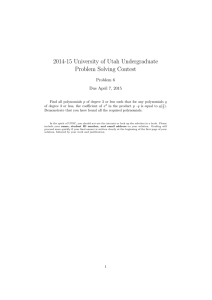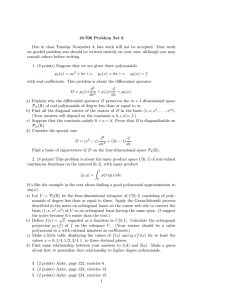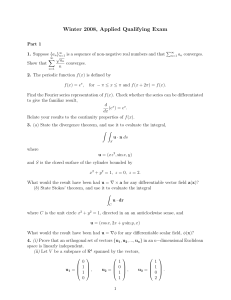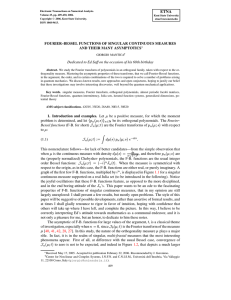ETNA
advertisement
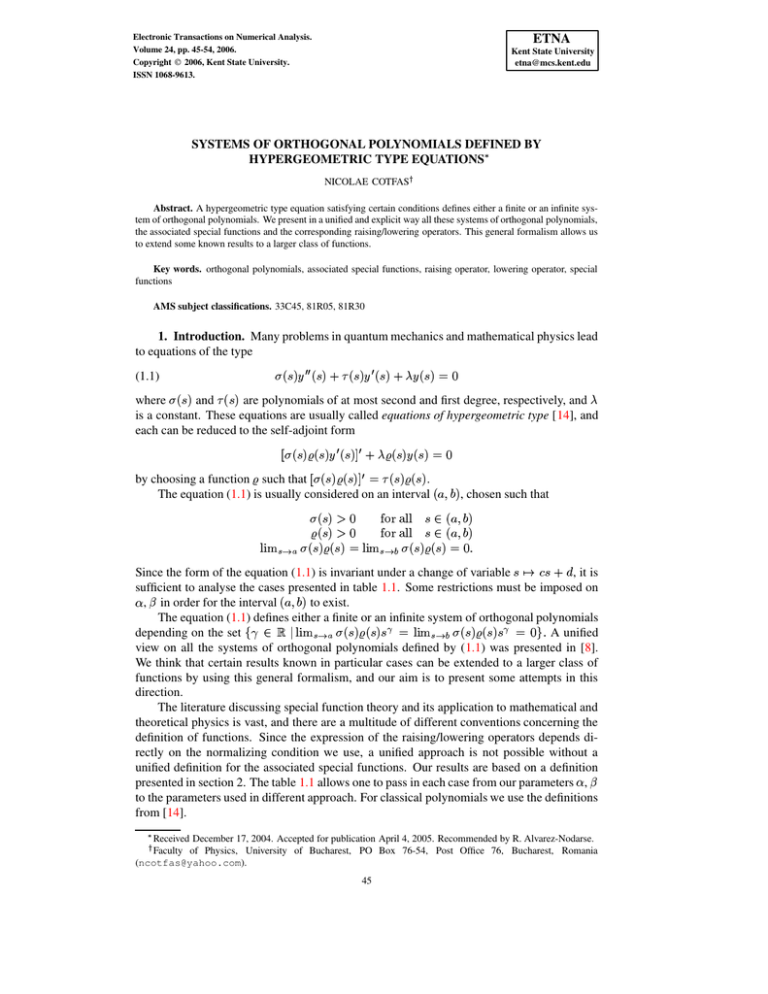
ETNA
Electronic Transactions on Numerical Analysis.
Volume 24, pp. 45-54, 2006.
Copyright 2006, Kent State University.
ISSN 1068-9613.
Kent State University
etna@mcs.kent.edu
SYSTEMS OF ORTHOGONAL POLYNOMIALS DEFINED BY
HYPERGEOMETRIC TYPE EQUATIONS
NICOLAE COTFAS
Abstract. A hypergeometric type equation satisfying certain conditions defines either a finite or an infinite system of orthogonal polynomials. We present in a unified and explicit way all these systems of orthogonal polynomials,
the associated special functions and the corresponding raising/lowering operators. This general formalism allows us
to extend some known results to a larger class of functions.
Key words. orthogonal polynomials, associated special functions, raising operator, lowering operator, special
functions
AMS subject classifications. 33C45, 81R05, 81R30
1. Introduction. Many problems in quantum mechanics and mathematical physics lead
to equations of the type
(1.1)
where and are polynomials of at most second and first degree, respectively, and is a constant. These equations are usually called equations of hypergeometric type [14], and
each can be reduced to the self-adjoint form
!
" #!$%&
by choosing a function such that '
" ( ! .
The equation (1.1) is usually considered on an interval *),+.-/ , chosen such that
102
3547698;:<:=?>@),+.-A
102
3547698;:<:=?>@),+.-A
:CB<DFE$G?H9 !I:<BCDFE$G?JK'%&ML
Since the form of the equation (1.1) is invariant under a change of variable ?NOQP/R#S
, it is
sufficient to analyse the cases presented in table 1.1. Some restrictions must be imposed on
T , U in order for the interval *),+.-A to exist.
The equation (1.1) defines either a finite or an infinite system of orthogonal polynomials
depending on the set V/W >(XZY
:CB<D E$G[H '\^]_:<BCD E$G?J '\^]`a7L A unified
view on all the systems of orthogonal polynomials defined by (1.1) was presented in [8].
We think that certain results known in particular cases can be extended to a larger class of
functions by using this general formalism, and our aim is to present some attempts in this
direction.
The literature discussing special function theory and its application to mathematical and
theoretical physics is vast, and there are a multitude of different conventions concerning the
definition of functions. Since the expression of the raising/lowering operators depends directly on the normalizing condition we use, a unified approach is not possible without a
unified definition for the associated special functions. Our results are based on a definition
presented in section 2. The table 1.1 allows one to pass in each case from our parameters T , U
to the parameters used in different approach. For classical polynomials we use the definitions
from [14].
b Received December 17, 2004. Accepted for publication April 4, 2005. Recommended by R. Alvarez-Nodarse.
Faculty of Physics, University of Bucharest, PO Box 76-54, Post Office 76, Bucharest, Romania
(ncotfas@yahoo.com).
45
ETNA
Kent State University
etna@mcs.kent.edu
46
N. COTFAS
TABLE 1.1
The main particular cases
c
c [
n h
h n c
h
h c
T T T T T T T +U
Tm T[m , U 0s
T[m U m n T
n U msTxm T[m , U 0s
Tm U
!
U
U
U
U
U
E
f'g.hjilk!E
de
kMqr de E
c t qu e qKk7v*g.hAqr c n[ qu e ilkwv*g.hAqr
c u e qk7vgjh/qr Kn c u e ik7v*g.hAqr
e qlh d qkwg'E
c # h e g.h/qr d ky.z5{|*y.}E
*),+'-A
$npo+'o#
M+ o
$n c + c c + o
M+ o
$npo+'o#
2. Orthogonal polynomials and associated special functions. In this section we review certain results concerning the systems of orthogonal polynomials defined by equation
(1.1) and the corresponding associated special functions. It is well-known [14] that for
~M , where
c
n n@
n
>
u k7v
e of at most degree
#M &
ML
(2.1)
If the degree of the polynomial is then it satisfies the Rodrigues formula
I
!"
where is a constant. We do not impose any normalizing condition. Each polynomial
the equation (1.1) admits a polynomial solution
defined only up to a multiplicative constant. One can remark that
$E :CBCG?D H !j ]
c
c
in the case 1> V +7+ n
B<D H '\ ]
E$:CG[
in the case 1>
E$:<BCG?D J 'j ] ha
W > M+'o#
35476
W > +/n T , and
E$:CB<G[D J !\ ] &
h c h
V n +9 +
o
rq
he
354;6
h ca
. Let
is
1> V c +7+ c n h a
1> V h n c + h + h c awL
a
P ROPOSITION 2.1. [14, 8] a) V Y m
is a system of polynomials orthogonal with
*
,
)
.
+
/
weight function
in
.
b) is a polynomial of degree for any m
.
\
A
c) The function
is square integrable on ),+.-A for any m
.
354;6
354;6
ETNA
Kent State University
etna@mcs.kent.edu
47
SYSTEMS OF ORTHOGONAL POLYNOMIALS
d) A three term recurrence relation
$ T ir U $ W qr c
c m
is satisfied for m .
),+.-A , for any m .
e) The zeros of are simple
u kwv and lie in the interval
The polynomials e can be expressed in terms of the classical orthogonal polynomials but in certain cases the relation is not very simple.
P ROPOSITION 2.2. [8, 9] Up to a multiplicative constant
w q n k
B3
% c
he
qlh
kMqr
e
B3
%
\n T u5qu ilk7v*g.h/qr u5q ilk7v*g.h/qr\v
B3
% c n h
e
e
u k7v
e I u5u qKk7v*g.hAqr u ilkwv*g.hAqr$v \n
B3
% h n c
e
e
E r q q,h k
k e
B3
% h
E
u5u i k7v*g.h/qr u q, k7v*g.hAqr$v
B e
*B¡
B3
% h c
e
s¢ £¢
¢u£ ¤ v
where
,
and
are the Hermite, Laguerre and Jacobi polynomials, respectively.
c
Let >¥
, m
, and let ¦ > V + +/LCL<LC+ a . By differentiating the equation (2.1) ¦ times
ª©^E « , namely
we obtain the equation satisfied by the polynomials §
© «
¨
§ 9 ¦ " § &nx § ML
(2.2)
¨
¨
¨
¨
This is an equation of hypergeometric type, and we can write it in the self-adjoint form
' " n § ¨
¨
¨ ¨ § ¨
by using the function % ¨ ' .
¨
D EFINITION 2.3. The functions
¨
­p®K¯°¯±¬% (2.3)
¨ %¬ ¨ $
¨
c
>¥
, m and ¦ > V M+ +/LCL<LC+ a , are called the associated special functions.
The equation (2.2) multiplied by ¬ ¨ can be written as
²
¨ ¨
¨
²
where
¨ is the differential operatorh
h
² ³n S h n@ S ¦ ¦ n * j
´
S!
S!
¨
c
¦
n
n \ n ¦ L
¦ ¦
P ROPOSITION 2.4. [8] a) For each ¦ m
orthogonal with weight function ! in )K+'-A .
, the functions
¨
with
¦ªµ m
are
ETNA
Kent State University
etna@mcs.kent.edu
48
b)
N. COTFAS
¨
is square integrable on
),+.-A
µ2¦¶µ m
for .
c) The three term recurrence relation
c
¨ ir l¸· ¬ ¦ n \¬ $¹
c
c
is satisfied for any m
and any ¦ > V + +/LCL<LC+ n
·
n c \¬ $¹ &
(2.5)
¬
(2.4)
For any
K#Mnº q r qr ¨
¨
. In addition, we have
n qr/ qr%ML
>¥
, m and any ¦ > V M+ c +^L<LCL<+ n c a , by differentiating (2.3), we obtain
qr \ ¬ ¨ M #¬ ¨ ir $
%
¬
¨
¨
ir
¦ ¨
¨
¨
that is, the relation
c
¬ %
ir
¨
¦ ¬ ¨
¬ ¨
which can be written as
·¬
(2.6)
If ¦
a
¨
S
n ¬ ¹ I ir» L
!S ¦
¨
¨
> V c + /+ LCL<LC+ n c a then by substituting (2.6) into (2.4) we get
S
· ¬ ¦ n j¬ ¹ Mln qr qr &
S! ¬
¨
¨
¨
that is,
· n¬ S n n¼ ¦ n c \¬ ¹ ir %Mn AL
Sw ¬ ¨
¨
¨
c
a . From (2.5) it follows that this relation is also satisfied for
for all ¦ > V M+ +/LCLCL<+ n
c
n
¦
.
(2.7)
The relations (2.6) and (2.7) suggest we should consider the first order differential operators [11, 7, 9]
½
¨
c
m
for ¦ ¬
S
n ¬ S! ¦
S
½ i ³
n¬ n
n2 ¦ n c \¬ !
S
¬ ¨
.
P ROPOSITION 2.5. [10, 6, 11, 8] We have
(2.8)
(2.9)
(2.10)
½
½ i ir ³M n[
ir
¨ ¨
¨
¨ ¨
½ i qr
½ i i9r
½ i
¨ Mln¨ lnx¨ ir LCL<L lnx qr
¨
¨
YCY 9i r YCY; ,n CY Y YCY
¨
¨
¨
¾l¿
¨ ¨
¾l¿
¾l¿
° µ#¦ m m L
°# µ¦ m m L
°À µ¦ m m L
ETNA
Kent State University
etna@mcs.kent.edu
49
SYSTEMS OF ORTHOGONAL POLYNOMIALS
²
½ i ½
¨ ¨
² ½ i ½ i ² i r
¨ ¨
¨ ¨
¨
nx
²
¨
irIn
½
¨
²
¨
¨
²
¨
½
¨
¨
ir ½
½ i
¨
¨
¾l¿
¾l¿
°
°
c
¦ m
c
¦ m L
Á From (2.8), (2.9) and (2.10) it follows that the normalized associated special functions
¨ ¨Ã Y<Y ¨ Y<Y satisfy the relations
½ Á ÅÄ n Á ir
½ i Á irRÄ n Á
¨ ¨
¨ ¨
¨ ¨
¨ ¨
<
É
Ë
(2.11)
Á
Á
¨ ÈÆÉql«Ç È Ä ÈÆ Éql«Ç È ÇwÊ LCL<L Ä ÈÆ ÉqlÇ ÈÊ É<Ë
L
«
« Ç!Ê
Ê
3. Á A group theoretical approach based on projection method. The system of functions
is the projection of the system of functions [1, 2, 13]
¨
(3.1)
Y + ¦ ÍÌ*),+.-/1Î nRÏ+\Ïl"n,OÑÐ
Y + ¦ d ¨RÒ Ó Á
¨
orthogonal with respect to the scalar product
Ô*Õ +jÖ?×I
J
c
Ä ÏÙØq Ú Ø H
Ú
Õ 7+jÛÖs;+.Û,! ÛÍL
Á
More exactly, we can identify each function
with the restriction of Y + ¦ to the subset
*),+.-/Î V a . By using the relation Ü Y + ¦ ³ ¨ B ¦ Y + ¦ obtained directly from definition
ÜÒ
(3.1), and (2.11) we get
c
d Ò ¬ Ü E B¡¬ Ü Y + ¦ Ä lnx ¨ Y + ¦ Ü
ÜÒ
qK
c
d Ò n¬ Ü E Bݬ Ü nÞßà ¬ Y + ¦ Ä n ¨ Y + ¦ L
Ü
ÜÒ
These relations suggest we should consider the first order differential operators
(3.2)
i ¬ E Bݬ Ü
Ü
d Ò
Ò
Ü
Ü
K
q
qÙ
Þ ¬ d Ò n¬ Ü E B¡¬ Ü n ßt
Ò
Ü
Ü
á ânRB
Ü
ÜÒ
satisfying the relations
i Y + c
¦ Ä nx ¨ Y + ¦ q Y + c
¦ nx ¨ qr Y + ¦ n á Y + Y + AL
¦ ¦
¦
One can remark that i Y + ×( and
c
c
c
Y + ¦ q9 q ¨ Y + Ä lnx nx iräã^ã/ã ,n qr
¨
¨
ETNA
Kent State University
etna@mcs.kent.edu
50
N. COTFAS
c
for all ¦ > V + + +^L<LCL<+ n
Legendre polynomials ¬I
ca
ix ¬ E Bݬ d Ò
Ü
Ü
Ü
ÜÒ
K
q
qÙ
d Ò n¬ Ü E Bݬ
Ü
whence
I
q Y +.7æ
å
and
, but, generally,
Ä c n h , %n
. For example, in the case of
Ü n d Ò ¬ Ü E B¡¬ Ü ân i
ÜÒ
Ü
ÜÒ
q ¨ Y +jw³\n c ¨ d q, ¨RÒ $n c ¨ Y + ¦ 354;68»:C: ¦ > V c + +^L<LCL<+ a
¨
ir Y +.7
c
and q
. The -dimensional vector space spannied by the set V q ¤ Y + Y.çà>
V + c + +^L<LCLC+ a1a is invariant under the action of i , q and á .
%á + Iè "&é Iè
The operators defined by (3.2) satisfy the relations
and
h
h
iÍ+ q"ê\nR ¬,¬ ¬ ëB ¬K¬ ¬ Ü
ÜÒ
n T ë
354;6
R> V c +9;a
354;6
I c n h
íì %á n e ih h ëî
n ì á e q,h h ë î
354;6
R> V h n c + h + h c a
where ë is the identity operator. The Lie algebra ï generated by i and q is finite dimensional.
T HEOREM 3.1.
¯ ¯^ó-A¯^°ôÃ) !ô ¯-'°)î c
ð
ð ¾ 1> V +;a
h
c
ð ¾ % nx
ïæð ð ¿ ¦ ¿ °'ñ,® ð PÙò ¿ ^õ9 h c h h c
^õ9 c + c ð ¾ 1> V n + +K a
c
c
c
Proof. If ö> V +M;a then the operators
÷ è i ¸ n  T i and ÷ q n? n  T q
satisfy the relations ÷ i1h + ÷ q"l³n1ë and ë!+ ÷ "(ML
i
q
á á n e ih h ë
c n¥
In the case %
the operators ÷ i@
, ÷ qø
and ÷
satisfy
á è
è L
á
÷
the relations h ÷ iÍ+ ÷ h q"h and ÷ + ÷ "é ÷
c
c
i , ÷ q q and ÷ á %á e q,h h ë
If Ã> V n + +K a the operators ÷ i2
á è
è L
á
satisfy the relations ÷ i1+ ÷ qh "l³n ÷
and ÷ + ÷ "lÅé ÷
c
n , the functions Y + ¦ satisfy the relations
In the case %
á
Ó
354;6 ¦ > V M+ c +/LCLCL<+ a
÷ Y + ¦ ;ø ¦ n Y + ¦ c
c
354;6 ¦ > V M+ c +/LCLCL<+ n c a
÷ i Y + ¦ 7 n ¦ A ¦ n T n Y + ¦ c
c
c
÷ q Y + ¦ ; n ¦ / ¦ n T n Y + ¦ n ù354;6 ¦ > V + +/LCLCL<+ a
ú Y + 7 Ó Ó c Y + 354;6 ¦ > V M+ c +/LCLCL<+ a
¦
¦
ú
á á
Ó
c
where ÷ q ÷ i h ÷ ÷ h xë;h is the Casimir operator of ^õ and n e h n .
c
c
+, + a , the functions Y + ¦ satisfy the relations
In the case 1> V n
á
Ó
354;6 ¦ > V M+ c +/LCLCL<+ a
÷ Y + ¦ ;ø ¦ n Y + ¦ c
c
354;6 ¦ > V M+ c +/LCLCL<+ n c a
÷ i Y + ¦ 7Ù ¦ n A ¦ T n Y + ¦ c
c
c
÷ q Y + ¦ ;ø ¦ n n / ¦ T n Y + ¦ n ù354;6 ¦ > V + +/LCLCL<+ a
ú Y + 7ºn Ó Ó c Y + 354;6 ¦ > V M+ c +/LCLCL<+ a
¦
¦
ETNA
Kent State University
etna@mcs.kent.edu
51
SYSTEMS OF ORTHOGONAL POLYNOMIALS
ú
á
á
c c
Ó
c
xë; is the Casimir operator of ^õ + and e h n .
where ÷ q ÷ iøn ÷ ÷
®
The Casimir operator of
is the identity operator ë belonging to the algebra [5].
Our approach is different from the one presented in [12] based on ô +.P/ and Miller
á
algebra ®û . Generally, our algebra ï does not contain .
coherent states. InÁ this section
the case I>
h a7L systems of >
Á ir we+ restrict
Á ih us+^L<LCto
c +.74.+ c nRSome
+
L
For each ¦
, the sequence
is an orthonormal
V
¨ ¨ ¨ ¨ ¨ ¨
basis in the Hilbert space
ü
J
h
K
Ì
*
,
)
.
+
A
Í
l
n
Ñ
O
Ñ
Ð
ý
§
ýý Ø H Y § /Y $S! m oÿþ
ýý
J
Ô 7r Y h×;
r § hw,$S!%L
§ §
Ø H §
The linear operator defined by (see figure 4.1)
Á Á ir ir
¨ ¨
¨
i ½ +) i ½ i
)
is a unitary operator, the operators
¨
¨ ¨
¨
¨ ¨ are mutually adjoint, and
Á
Á
) Ä nx qr
35476 ¦ c
¨i Á ¨
¨
¨
) ir1n Á ir
35476 ¦
(4.1)
¨
¨ v É<Ë ¨
¨Á
¡
u
H
Á
qÈ v ¨ ¨ 35476 0 ¦ L
¨ Ä uCÈÉ*qlÈ vuCÈÉ<Ë «Ç qlÈ « v uCÈ
«
« Ç!Ê «
Ê «
¨
Ì ü nlO ü +
Since
) ) i Á M i9r n Á
¨ ¨ ¨
¨
² n &) i
we get the factorization
¨
¨
¨
) +j) i " Á
(4.2)
¨ ¨ ¨
)
) i ) Á lnx Á
¨
¨
¨ ¨ ¨
¨
¨
and the relation
ir1nx Á L
¨
By using the operator
Á n n T Á
¨
¨
¨
¨
¨ ¨
i
the relation (4.2) can be written as ) +.) "l³n
¨ . Since
¨ ¨
+j) i "lân ) i
+.) "l )
¨
¨ ¨
¨ ¨
¨
i
it follows that the Lie algebra ï
generated by V ) +j) a is finite dimensional.
¨
¨ ¨
T HEOREM 4.1.
¯ ^¯ó- ¯°ôä) ô!¯-'°)î °1> V c +;a
ð
'
°
,
ñ
®
P
ò
l
¾
¿
ï ¨ ð 𠿦 ¿
ð ¿
^õ9 c + c °% c n h
¾l¿
c
Proof. In the case > V +.;a the operatori
is a constant operator, namely,
¨
¨
c
c
n T . Since Tm , the operators i n T ) , qø n T ) and ë form a basis
of
 ¨
 ¨
ï ¨ such that
i + q "ân1ë
ëw+ è "(
Ìü
nKO ü
ETNA
Kent State University
etna@mcs.kent.edu
52
N. COTFAS
LLL
LLL
½ ái
Á á Á r
½ á
) ái ) á á i ) i r ) r ½ á
Á h
á Á h
r
½ á
i) á ) á
i
á
½ i ) r ) r á
Á r
á Á r
r
½ á
i) á ) á
á Á á
á
F IG . 4.1. The operators , ½ ir
½ r
r
½ ir
½ r
r
,
LLL
Á h
) ih ) h Á h
h
, and
LLL
Á
½ h h
½ ih
relating the functions
.
isomorphic
to thei Heisenberg-Weyl algebra ® .
h
¨ c is
á
n then ÷ i) , ÷ qø() and ÷ form a basis of ï
¨ such that
i + q "l¨ ân á ¨ á + è "l¨ é è L
÷ ÷
÷
÷ ÷
÷
h
Á
Á
c
n , the functions
+ ir + Á ih +/LCLCL , satisfy the relaIn the case R
¨p ¨
¨ ¨
¨ ¨
tions
Áá ì n î Á
÷ ¨
eh ¨
Á
Á
c
÷ i ¨ n ¦ A ¦ n T ir ¨
Á
Á
c
÷ q ¨ n ¦ / ¦ n n T qr ¨
Á
ú Á ³n ì h n î ì h n
e ¦
e ¦ c î ¨
¨
ú
á á xë;
c c
where ÷ q ÷ i n ÷ ÷
is the Casimir operator of ^õ + . If we denote
T
á Ó
Y Ó +\ó× Á i ¢
¦ n n
¨ ¨
that is, ï
If I
then the above relations can be written as
á Y Ó \+ ó× Ó
÷ i Y +\ó×
Ó
÷ q Y +\ó×
ú Y Ó +\ó׳n Ó
á
óY Ó +jó×
Ó á óF c A á n Ó óY Ó +jó~
Ó á ó/ á n Ó ó¥n c Y Ó +\ó¥n
Ó c Y Ó +jó× L
c n h
c
and show that [3, 15], in case R
, the
of ^õ9 +
i representation
ü
ì eh n î
in is the irreducible discrete representation ¦ . c
Let ¦ >
be a fixed natural number. The functions Y 7× , Y × , Y × , ã/ã^ã
Y ó×% Á i ¢
¨ ¨
÷
satisfy the relations
)
Y ó×% Ä ¯ ¢ Y ó¥n c ×
) Y ó×% Ä ¯ ¢ i r Y óF c ×
¨
² n /Y ó
× &¯ ¢ Y ó×
¨
¨
¨i
c×
c×
c
defined by (4.1)
, where
ETNA
Kent State University
etna@mcs.kent.edu
53
SYSTEMS OF ORTHOGONAL POLYNOMIALS
where
n T ó
ó5óF ¦ n T n c ¯ ¢ i ¢ nx ¨
¨
B3
B 3
1> V c +'»a
% c
n hL
Some useful systems of coherent states can be defined [3] by using these relations, the confluent hypergeometric function
c
c
" h
"
á Õ r *P!#"! c c " %
c
$
c
$
c
P
P»P% »P P% A *P% &$ /ã ã^ã
and the modified Bessel function
Ï * q ' + "w9n * ' )"!
)
!
"
÷('
, .B -?0/!Ï
T HEOREM 4.2. a) If 1>
c
V .+ ;a
6
132 d d
¢
4
ì hr " î ' ih
5
* +"w
L
'
¢!6 á ó $#7 0/?óF c V Y "w×ÍY"F>öÐIa , where
¢
f 54
"
Y "!× 9d 8 f :;< 8
Y ó×
¢%6 á ó $ \n T ¢
ü
is a system of coherent states in such that
n c
Ô ",Y "w× c
) Y "!×="lY "w×
)7óS
S,)@ d "wMSK)A
DB"!/Y "w× Ô "lY»2ëL
Ï T Ø?>
¨
c nx h
b) If %
then V Y "w×IY"t>ÐIa , where
¢
4
"
5
7
Y "w× ¦ n T Y ó×
¢!6 á ó $#7 *ó~ ¦ n T ü
is a system of coherent states in
then
such that
Ô "lY "w× á Õ r n T Y "lY h ¦
)
¨
Y "w×=",Y "w×
)wóS
Ø?>
SDC)"!Y "w× Ô "lY»¼ë
where
°h q
¨ e
°»S7°S%E
)wóS
" ¼° d GF L
(4.3)
Ï 7 ¦ n T ÷ < Ç!f Ê q ¨
f
Proof. [3] By denoting ònIH and using the integration by parts we get
e
¢ ¢L
h ¢ ¢L
n c
n c 5 M 4 <f
° i i9r
Cu q v+F SDE P~Y ó× Ô ó Y
Ô
S,)@ d "wS,JA
DK"!/Y "w× "lY»
;
S
°
¢
!
¢
L
Ï T Ø>
Ï T ¢ ¢%L Ø á dON ó $ ó $ \n T i
Ø á dÚ
¢
h
4 f c
4 qRQ ò ¢
n 5
°
5
Ô
<
·
·
¹ °9S7° ¹ Y ó× ó%Y
·
T
S7ò ¹ Y ó× Ô ó%Y 5 Y ó× Ô ó%Y;(ëwL
¢ Øá d N ó $ n T
¢ Øá d ó $
¢
SDC)"!%
Denoting SDCºSC*°MS;°SDE we get
4
4 ¢
Ï 7 n T ¦
· á °h SDC)"!Y "!× Ô ",Y» 5
C 5°»S7° ¹ Y ó× Ô ó%Y
#
$
7
¢!6 á ó 5 óF ¦ n T Ø
?Ø >
ETNA
Kent State University
etna@mcs.kent.edu
54
N. COTFAS
and hence, we must have the relation (Mellin transformation)
Ï 7 n T ¦
Ø á
(4.4)
The formula [4]
Øá
4
4
¢
°h C 5°»S7°à 7 *ó~ c 7 *ós ¦ n T L
!TOU iWV U qRV Ä T T ¢ q r S T 7 YX ó 7 !Z ó
÷
T ° h X hr Z ¦ n e h becomes
,
,
4 h¢
´
° ÷ < q °»!° h ¨ q e S7°í 7 *óF c 7 *ós ¦ n T L
(4.5)
Ø á
!Çf Ê ¨
for
The relations (4.4) and (4.5) lead to (4.3).
Acknowledgements. This work was supported by the grant CERES 4-192.
REFERENCES
[1] Y. A LHASSID , F. G ÜRSEY AND F. I ACHELLO , Group theory approach to scattering, Ann. Phys., 148 (1983),
pp. 346–380.
[2] N. M. ATAKISHIYEV , Construction of the dynamical symmetry group of the relativistic harmonic oscillator
by the Infeld-Hull factorization method, in Group Theoretical Methods in Physics, M. Serdaroglu and E.
Inonu, eds., Lecture Notes in Physics, 180, Springer-Verlag, 1983, pp. 393–396; Ibid. Theor. Math. Phys.,
56 (1984), pp. 563-572.
[3] A. O. B ARUT AND L. G IRARDELLO , New ”coherent” states associated with non-compact groups, Commun.
Math. Phys., 21 (1971), pp. 41–55.
[4] B ATEMAN P ROJECT , Integral transformations, vol. I, Erdelyi, ed., McGraw-Hill, New York, 1954, p. 349.
[5] J. B ECKERS AND N. D EBERGH , On generalized coherent states with maximal symmetry for the harmonic
oscillator, J. Math. Phys., 30 (1989), pp. 1732–1738.
[6] F. C OOPER , A. K HARE AND U. S UKHATME , Supersymmetry and quantum mechanics, Phys. Rep., 251 (1995),
pp. 267–385.
[7] N. C OTFAS , Shape invariance, raising and lowering operators in hypergeometric type equations, J. Phys. A,
35 (2002), pp. 9355-9365.
[8] N. C OTFAS , Systems of orthogonal polynomials defined by hypergeometric type equations with application to
quantum mechanics, Cent. Eur. J. Phys., 2 (2004), pp. 456–466.
[9] N. C OTFAS , http://fpcm5.fizica.unibuc.ro/˜ncotfas.
[10] L. I NFELD AND T. E. H ULL , The factorization method, Rev. Mod. Phys., 23 (1951), pp. 21–68.
[11] M. A. JAFARIZADEH AND H. FAKHRI , Parasupersymmetry and shape invariance in differential equations of
mathematical physics and quantum mechanics, Ann. Phys., 262 (1998), pp. 260–276.
[12] M. A. JAFARIZADEH AND H. FAKHRI , The embedding of parasupersymmetry and dynamical symmetry into
group, Ann. Phys., 266 (1998), pp. 178–206.
[13] E. D. K AGRAMANOV, R. M. M IR -K ASIMOV, AND S H . M. N AGIYEV , The covariant linear oscillator and
generalized realization of the dynamical
symmetry algebra, J. Math. Phys., 31 (1990), pp. 17331738.
[14] A. F. N IKIFOROV, S. K. S USLOV AND V. B. U VAROV , Classical Orthogonal Polynomials of a Discrete
Variable, Springer, Berlin, 1991.
[15] B. G. W YBOURNE , Classical Groups for Physicists, Wiley, New York, 1974.
[\^]_a`bdc
eO ]+fg`hf#c
